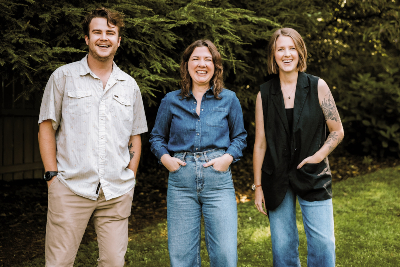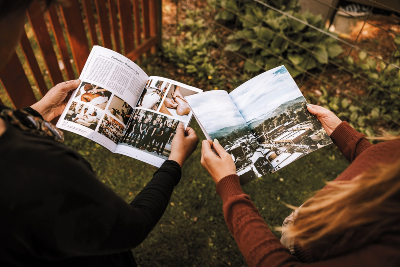




It’s the Look for Us
A small publisher in the heart of the Blue Ridge Mountains is changing the face or regional advertising. Territory‘s lead writer shares their story.
By Ally Carlton
SSince the release of our first issue in 2022, Territory has garnered attention for its unique style and nontraditional approach. The brainchild of our owner and editor-in-chief Emrie Jackson, the annual regional publication arose because she saw a void: a lack of local advertising done well—or at least, accurately representative of Brevard, North Carolina, the town we call home.
Brevard is nestled in the western corner of the state, tucked away in the Blue Ridge Mountains. Although it has undergone significant growth in the last 20 years, it has retained its quiet charm and congeniality. It’s a sanctuary for outdoor enthusiasts, artists, travelers, and adventure-seekers. The culture is laid-back and inviting, with a reverent fondness for the region thrown in. With a population of less than 8,000, Brevard still has a small-town vibe.
When Jackson moved here twelve years ago, she fell for the land- scape. It’s hard not to. Every season offers a new lens through which to behold the endless canvas of natural beauty. In a short time, she developed a deep admiration for the community as well. The people of Brevard are friendly. They’re warm-hearted. They look out for each other. There’s a reason so many visitors end up moving here—they come for the mountains; they stay for the community.
Tourism plays a tremendous role in the economy of Brevard. Year after year, thousands of tourists flock to the forests to admire the changing of the leaves, revel in the views, and take advantage of the massive trail systems in Pisgah and Dupont Forests. Most locals have come to appreciate the ebb and flow of out-of-towners, as they under- stand how vital they are to the town’s economic well-being.
Although Brevard is not totally free of corporate franchises, the majority of businesses in town are locally owned and operated by people who have planted roots here and whose livelihoods depend on the influx of vacationers each season. Jackson realized there wasn’t a form of advertising in Brevard that provided the whole picture of our town, its entrepreneurial spirit, and the people behind the businesses. The only ads you would see floating around Brevard were the same as what you’d see in any other city: flashy, impersonal, and franchise-focused.
And that’s where Territory comes in.
As Jackson describes it, the mission of Territory is to highlight Brevard’s local businesses in a way that connects visiting tourists not just to products and services, but to the people who offer them—people dedicated to their disciplines and steadfast in their community.
Jackson had a vision: For the magazine to mirror the spirit of Brevard, the team needed to develop, foremost, a strong aesthetic that would effectively represent the town’s unique vibe.
The culture of this little mountain town is warmer, more organic, and more inviting than any place Jackson had ever been. So, in the pages of Territory, the gentle color palette of earth tones is warm; the contrast is low; the fonts are congenial and unassuming; and the neat- ness and symmetry of the layout is visually pleasing. The magazine’s general disposition is quietly classic, elegant, and inviting—polished, but personal.
Visually, Territory is stunning. If you were to walk into a coffee shop or store in town and see one, you’d be hard-pressed not to pick it up. It’s a richly satisfying experience to hold it in your hands and leaf through it. The team upholds the aesthetic through a series of choices, every detail considered with the character of Brevard in mind. The interior pages are 70-pound opaque smooth, an uncoated stock, so the feel is textured and the color slightly muted. The photography has a natural, candid, and genuine feel to it. The style is minimalistic and cohesive.
Are They Advertisers or Collaborators?
That’s our overall aesthetic style, but what is the content?, you might ask.
As you flip through the pages of the magazine, you will see business owners doing what they love and read about why they love it.
We don’t just enlist advertising from our local businesses; we create it. And we don’t call our advertisers “advertisers;” we call them “collaborators.”
When a business owner signs on for an issue of Territory, what they get is something we call an “aditorial,” an amalgam of an advertisement and an editorial. Each aditorial feature includes a collection of professionally taken photographs; a custom-written narrative about the business, the owner’s contact information, and a QR Code to the business’s website (rather than their logo—another way we keep the look clean and consistent). An aditorial can be a fractional, full page, or complete spread. In full, Territory is not just a print magazine, although that is the central pillar. We provide print, web, and social advertising. Every element in a print aditorial is also included in the corresponding online feature and social posts. Since Territory is an annual publication, the aditorials stay present and vibrant in our community for a full year.
To produce aditorials that capture the true essence of each business, we need to work together—to collaborate—and we believe that’s where the magic comes in.
Our team walks each collaborator through the creative process: We conduct an interview to learn about them; we execute a fun and creative photoshoot; and we allow time for a critical review phase. The whole operation involves a lot of client input; from the outset, we place emphasis on listening to and honoring the collaborator’s hopes and objectives for their aditorial.
During an Issue Two photoshoot with one of our local proprietors, we could sense that she wasn’t immediately comfortable having her photo taken—not uncommon, and not a problem. We take the emphasis off of staging stiff profile shots and put it on just being there to capture the owner and employees doing what they do. The finished spread for this particular business (a remarkably unique combination of gas station + indie market + eatery + live music venue!) featured the owner handing a freshly prepared sandwich to a customer while giving her a genuine smile. Another photo on the multishot spread zooms in on a custom- er’s hand pulling a delightfully gooey slice of pizza off a tray. The feel of the business is what we’re going for—not the stale, traditional photography seen in so many advertisements. Using this method, each aditorial connects the reader to the heart of the business. The result is a miniature profile piece that celebrates both the business and the person or people who worked hard to build it.
In keeping with the values of this tight-knit community, Territory also sponsors three nonprofit organizations each year as a way of expressing our gratitude for the spirit of generosity and compassion that flows through Brevard.
The Team Behind the Look
At only four people strong, the size of our staff presents as many advantages as it does challenges. Although there is much work to be divided up between us, being a small team makes cohesion easier to attain. The consistency of Territory’s aesthetic depends upon everyone being on board with it, embracing it, and applying it in the things for which they are responsible. The team Jackson has built embraces solidarity with each other and Territory’s purpose.
Lead Photographer George Carlton’s ability to tell a story through photographs has contributed to the success of the magazine in a major way. Carlton uses vision boards and pre-production meetings with our collaborators to help him identify their objectives and concerns. When approaching a photoshoot, he keeps one question in the forefront of his mind: How can I remain on brand with Territory while also representing the business the way they want to be represented? Building the shoot around the subject—the business’s products or services—while simultaneously capturing the collaborator in their element is key. He manages to represent the essence of each business, while maintaining Territory’s overall aesthetic, by using a consistent style of photography.
His lighting and angles, combined with his knack for playing around with depth of field to draw focus to a subject, result in a style that is both authentic and consistent. Collaborators are blown away by the final proofs, and we often receive positive feedback about the quality and style of Territory’s photography.
Our lead writers (Nancy Varella on Issues One and Two; myself on Issue Three) take a similar approach when structuring interviews with collaborators. After researching on the front end, we bring a list of questions to an interview to help discern what each business owner wants predominantly featured. We then let the collaborator take the lead, inviting them to tell their story. As business owners share the “why” behind their “what,” we look for opportunities for follow-up questions that enable us to write a Brevard-specific narrative that has a personal viewpoint. The writing style in Territory enhances the aesthetic with its tone—warm, but polished—and its focus, the people who have invested their lives in their businesses and who share a long-standing affection for the town in which they live. Although there are many stories in an issue of Territory, each one zeros in on both the history and uniqueness of the business. Lifelong locals frequently tell us that they learn new things about our community through the narratives in the magazine.
Rebecca Freeman is Territory’s project manager and chief wearer of many hats. She handles all of the logistics and most communication, enabling the rest of the team to focus on production. On the digital side, Freeman is responsible for Territory’s social media management and event calendar, ensuring stylistic consistency with the magazine. She also lends her eagle eye to the editing process, helping to move each aditorial across the finish line.
Jackson handles all things related to branding. The striking photos she chooses for each cover are but a precursor to many stylistic and design choices inside. By weaving our aesthetic through every element of the magazine’s branding, she reflects the aspects of Brevard that first inspired the idea for Territory.
The Future
Now working on our third issue of Territory, we have dialed in “the look.” And the feedback we receive only invigorates our efforts. Collaborators repeatedly validate our approach, design, and mission with positive feedback. Here are a couple of recent comments we’ve received:
“Territory provides an awesome vision of Brevard’s community and local businesses. So fun to work with these people and be a part of the vision of showing just how awesome Brevard and the surrounding region is!”
– Shine Family Chiropractic
“Great design. Great creativity. Great follow- through. Wonderful business promotion for collaborators!”
– Theophilus
Our defined aesthetic—thoughtfully planned and consistently applied—plays a crucial role in Territory’s success. And while positive feedback is always great to receive, the proof is in the pudding, right? Many of our existing collaborators, along with some new ones, have signed on for Issue Three. Readership and revenue have been growing. And we’re diversifying our offerings. For Issue Three, we designed the cover to feature a local business, and it sold immediately. We’re more than doubling the areas represented in our “Neighborhood Sponsorship,” in which sponsors get their logo printed on the back of our popular t-shirt series (one design per neighborhood). We have added a 30-second film commercial option available to businesses (for their unrestricted use) whether or not they are also signed on for an issue. And we are starting to lay plans for expansion. While we are certainly in a sweet spot here in Brevard, we’re already dreaming of bringing this concept to other towns.
Ally Carlton is lead writer of Territory. Emrie Jackson is owner, creative director, and editor-in-chief of Territory. Her life journey brought her to Brevard by way of Colorado, Michigan, Texas, and a year traveling exotic locales in the Pacific Rim. Connect via jackson@pagesthemagazine.com.

